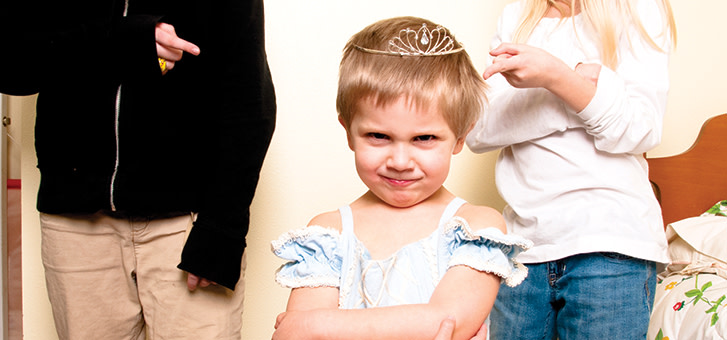Two-year-old Jamie pulls a pink frilly dress out of the toy-box. “I’m going to be a princess!” he announces.
“No, Jamie!” responds Emily, his four-year-old sister. “You can’t wear that! Only girls can be princesses!”
And Jamie bursts into tears. “But I am a girl!”
Katie’s dolls are in a box under her bed. She’d much rather build a train set, climb a tree or play football with the boys in her class.
Dave finishes work early. When he collects his young son Mark from a friend’s house, he finds them both dressed like girls, complete with lipstick and hair-bows. His friend’s older sisters have treated the boys like dolls for the day.
Just normal
Fortunately Jamie, Katie and Mark’s parents aren’t troubled by their children’s experiences. Jamie’s mum knows he’s too young to understand gender, and he just wants to be a princess so he can play with Emily’s castle. Katie has four older brothers, so it isn’t surprising that she wants to play like them. And Dave remembers being dressed like a girl by his big sister, and it never did him any harm.
It’s normal for children to experiment with a wide range of activities, because they’re still developing their own sense of self and their understanding of the concept of gender. They don’t see the world the way we adults do, with our strong ideas about what it means to be boy or girl. They experience it through their senses, and make decisions based on what they enjoy and what they don’t enjoy. When Jamie’s mum asked him what he liked about the princess dress, he said it was “all soft and swishy, with lots of pretty colours . . . not like my jeans. They’re all dark and boring.”
Gender concerns
Recently there have been debates in legislatures and the media about providing bathroom facilities for people who consider themselves transgender, and reports of a rise in the numbers of young children being identified as potentially transgendered. These issues can increase the concerns that some parents might have about their child’s behaviour. How can a parent know what is normal for their child? And how can they know if their child needs professional help?
What’s really going on?
Most children play in a fantasy world where they can become anyone they like. It’s good for them to experiment with being a fireman, a daddy, a ballerina or train driver. Each time they step into a different role, they’re learning new skills, seeing the world through different eyes and developing empathy for others. Boys can explore what it’s like being “Mummy,” and girls can likewise play at being “Daddy.” They learn about the people they meet every day and act out their different jobs and roles. These role-plays are an important aspect of normal development.
What’s happening in the family?
If a child becomes more interested in activities that seem unusual for their gender, then it’s worth looking at the bigger picture and wondering what’s happening in the family. If Mummy has just had a new baby, big brother might want to push a baby doll in a pram when they walk to the park. If Daddy is no longer a part of her family, a daughter might start to take a more masculine role in the home.
Harriette came from a home where her father had five daughters but desperately wanted a son. He gave them all names that were feminine variations of typically male names, and they were raised like boys. Two of the girls enjoyed being tomboys, but the other three became as feminine as possible as soon as they had a chance.
Peter’s mother desperately wanted a daughter, so she happily encouraged him toward more feminine toys and choices.
Explain how others see them
Luke wanted to wear his sister’s mermaid costume for his class’s ocean-themed party. Instead of telling him he couldn’t wear it, his mother explained that it was a really beautiful outfit, and she could see why it would be fun to wear. She also told him that some of his friends might laugh at him if he went dressed as a mermaid, and she didn’t want him to feel sad at the party. “Okay, Mum,” he said, “Can I go as an octopus instead?” By gently explaining how others might respond to his choices she gave him the opportunity to make a different decision.
Be safe at home
Make your home a safe place for your child where he or she can experiment with different roles, games and choices. Gently accept their choices as if they are normal, because they probably are. Be respectful and don’t laugh at them or tell other people about the “amusing” things they do. But don’t indulge their choices either. It’s fine if they enjoy wearing their mother’s high-heels for a bit, but you don’t have to rush out and buy them a pair of their own.
Find help
In our culture most parents are less concerned about girls behaving like boys than the reverse. Girls can choose to wear trousers, play with cars and join a football team all without anyone making a comment let alone a fuss. But parents are more likely to be worried when their sons want to wear dresses, play with dolls and go to ballet classes.
It’s reassuring to know that most children go through phases where they show an interest in the clothes, toys and activities of the opposite gender. Most of them grow out of it fairly quickly, and they don’t develop life-long preferences. But if they’re being teased or bullied at school, or if your child is anxious and upset, or if anyone in the family is distressed by their choices, then it might be a good idea to find someone to talk to. A family counsellor can help you and your family to understand your child’s world and explore the best way to support each other.
Always be there
The most important thing your child needs to know is that you will always be there for them, loving, encouraging, supporting and accepting them, whatever choices they make, whatever interests they pursue and whatever talents they develop. A friend of mine told her teenage children, “If ever you think you are gay or transgendered, or if you are pregnant, or struggling with drugs, or debt, or if you have any other challenges like that, then I simply want to be the first to know. I will always love you and be there for you, and this will always be your home.”
Rethink ingrained attitudes
We need to reflect on our own attitudes toward gender. Why do we feel so strongly about things we have artificially “gendered” in our society? In the nineteenth century, boys were often dressed in pink because it was simply a strong colour. It had no connotations. In fact girls were more likely to wear blue and white, which were thought to be daintier colours. Many ideas and ideals surrounding gender have been created by our cultures, communities and families, not nature. They can change quickly, according to circumstances and events.
It is good for boys to cry, develop empathy and show compassion for others, because it means that they are less likely to become aggressive and hurt other people as adults. It’s fine for girls to play soccer, do science at school, fly planes and become engineers, if that’s where they exhibit talent. And it’s fine for boys to wear pink shirts, and girls to wear denim overalls, if that’s what they want to dress in.
But what are your expectations of girls, boys, men and women? Examine from where your ideas have come? Your family, your upbringing, your culture, your community, the media? How are you living them out in the way you relate to your children, and the people you meet every day? And what effect are your ideas having on the way you bring up your children, and how you relate to other people?
Be unique
The truth is, God made us each unique and wonderful1. He knows all about our DNA and how we’re wired2. He has given each of us different gifts to enjoy and share to make the world a richer and more interesting place to live3. And when other people behave in ways we don’t expect and make choices that seem unusual to us, this is an opportunity for us to show respect4, compassion5 and understanding6.
1. Psalm 139:13-14.
2. Psalm 139:13, 15.
3. Romans 12:3-8.
4. Romans 12:10a.
5. Romans 12:10b.
6. Proverbs 18:13.
More information:
http://www.apadivisions.org/division-44/resources/advocacy/transgender-children.pdf
http://www.jubilee-centre.org/gender-fluidity-bible/
Enjoying gender
- Encourage children to be happy and thankful about the positive aspects of their gender. Tell them: “I’m glad you are a girl (or boy) because . . .”
- Help your child to make a poster listing 10 reasons why they’re happy to be a boy or a girl. Tell them why you are glad you are a man or a woman.
- Give children plenty of special one-to-one times with the parent of the same gender, or other close and trusted adults who provide warm and positive same-gender role-models.
- Help your children to discover, enjoy, develop and celebrate their own unique talents and strengths, whatever they might be.
- Help them to make friends with children of their own gender, and to find fun things they can do together.
- Support your child if they are being bullied because of their size and shape, or because of their choice of clothes, activities, interests and friends.
- Encourage children to engage in gender-neutral play activities, hobbies and sports such as board games, cycling, swimming and nature studies.
- Encourage each child to learn important life-skills regardless of their gender. Girls need to maintain their own cars and fix things around the home, and boys need to know how to cook their own food and wash their own clothes.
- Avoid statements like, “Boys don’t cook!” or “Men don’t like pretty things,” or, “Why would you want to be a nurse? That’s a girl’s job!” if your son is interested in helping boys to find positive role models of male chefs, artists and nurses. Equally, girls can climb mountains, make scientific discoveries and become good plumbers.
- Make sure your child knows, without a speckle of doubt, that you’ll always stand by them, love them and support them, whatever their differences, challenges, choices and gifts.







